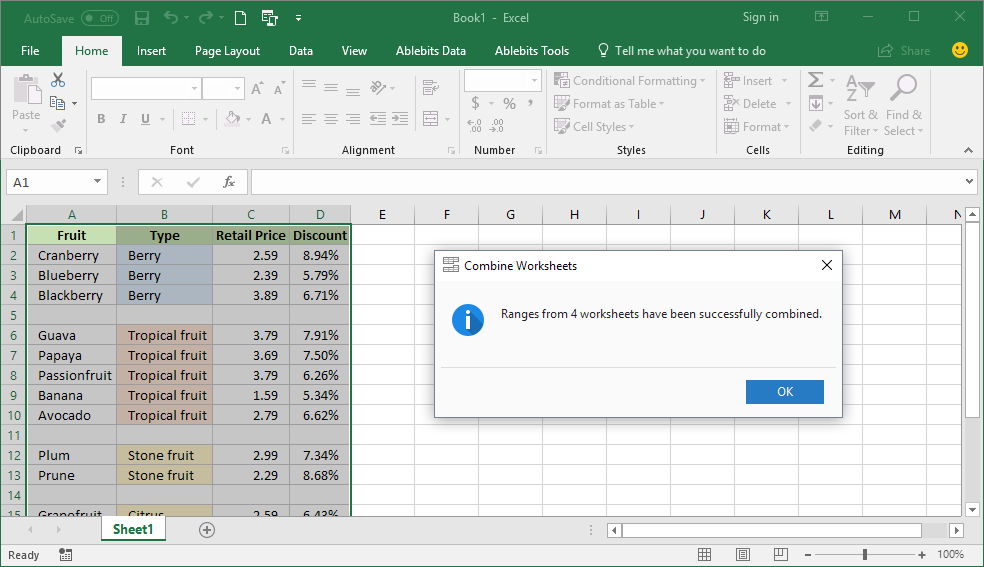Effortlessly Merge Multiple Excel Sheets: A How-To Guide

In today's data-driven world, managing spreadsheets efficiently can significantly boost productivity. If you often find yourself juggling multiple Excel files or sheets, you know the pain of manual data consolidation. Fortunately, Excel offers several methods to merge these sheets automatically, saving time and reducing errors. This guide will walk you through various techniques to merge multiple Excel sheets effortlessly, ensuring your data management tasks become as smooth as possible.
Why Merge Excel Sheets?

Before diving into the how-to, let's quickly cover why merging Excel sheets is essential:
- Data Consolidation - Combine data from various sources into one comprehensive dataset for analysis.
- Automation - Reduce manual work, thus minimizing human error and increasing efficiency.
- Reporting - Create unified reports without manually copying and pasting data.
Methods to Merge Multiple Excel Sheets

1. Using the Consolidate Feature

Excel’s Consolidate feature allows you to combine data from multiple sheets or workbooks into one master sheet, with options for various mathematical operations.
- Step 1: Open the workbook where you want to merge the sheets.
- Step 2: Go to the "Data" tab and click on "Consolidate."
- Step 3: In the Consolidate dialog, choose the function you want (e.g., Sum, Count, Average).
- Step 4: Add the ranges from the source sheets by clicking "Add" for each range.
- Step 5: Check the "Create links to source data" option if you want to dynamically update the master sheet when source data changes.
- Step 6: Click "OK" to complete the merge.
🔗 Note: If you check "Create links to source data," any changes to the source sheets will automatically update your consolidated sheet.
2. VBA (Visual Basic for Applications) Macro

For those who prefer a more customizable or automated approach, VBA can be used to write scripts that will merge data in a matter of clicks:
- Step 1: Open the VBA Editor (press Alt + F11).
- Step 2: Insert a new module (Insert > Module).
- Step 3: Write the VBA code to loop through sheets, extract data, and merge it into a master sheet.
Sub MergeSheets()
Dim ws As Worksheet
Dim MasterWs As Worksheet
Dim SourceRange As Range
Dim DestRange As Range
Dim LastRow As Long
Set MasterWs = Sheets("Master")
For Each ws In ThisWorkbook.Worksheets
If ws.Name <> MasterWs.Name Then
'Find the last row with data in the source sheet
LastRow = ws.Cells(ws.Rows.Count, "A").End(xlUp).Row
'Define the source range
Set SourceRange = ws.Range("A1:D" & LastRow)
'Find the last row with data in the master sheet
LastRow = MasterWs.Cells(MasterWs.Rows.Count, "A").End(xlUp).Row + 1
'Define the destination range
Set DestRange = MasterWs.Range("A" & LastRow)
'Copy and paste data
SourceRange.Copy DestRange
End If
Next ws
End Sub
Step 4: Run the Macro (press F5 or from the developer tab).
💡 Note: Customize the above VBA code to handle specific column or row positions as per your needs.
3. Power Query (Excel 2010 and Later)

Power Query offers powerful data transformation capabilities in Excel:
- Step 1: Go to the Data tab and select "Get Data" > "From File" > "From Workbook."
- Step 2: Choose the Excel workbook containing the sheets to merge.
- Step 3: Select the sheets you want to merge from the "Navigator" pane.
- Step 4: Use the "Append Queries" feature to combine the data from selected sheets into one query.
- Step 5: Load the data into Excel and save your work.
Selecting the Right Method

The method you choose for merging Excel sheets depends on several factors:
| Method | Pros | Cons | Best for... |
|---|---|---|---|
| Consolidate | Simple to use; built-in Excel feature; supports calculations | Less flexible for complex data arrangements | Quick reports, basic data consolidation |
| VBA Macro | Fully customizable; automates repetitive tasks; can handle complex data merging | Requires VBA knowledge; might be time-consuming to set up | Regular merging tasks, custom data processing |
| Power Query | Handles data from various sources; great for ETL operations; saves query steps | Requires newer Excel versions; learning curve | Data transformation, ETL processes, data from multiple files |

📈 Note: Power Query can load data directly from other files, making it exceptionally useful for large datasets or data spread across multiple files.
By leveraging these techniques, you can not only streamline your data management but also enhance your analytical capabilities. Whether it's for regular reporting, one-time data consolidation, or handling complex data scenarios, there's a method suited for every need. Remember, the key to successful data merging lies in understanding your dataset's complexity, your level of Excel proficiency, and the frequency of the task.
Merging multiple Excel sheets doesn't have to be a daunting task. With the right tools and knowledge, it becomes a swift operation that can dramatically improve your productivity. Implement these strategies and transform your approach to Excel data management.
What is the simplest method to merge Excel sheets?

+
The simplest method to merge Excel sheets is using the Consolidate feature, which is native to Excel and requires minimal setup.
Can I merge data from different Excel files using Power Query?

+
Yes, Power Query can load and merge data from multiple Excel files or sheets, making it versatile for data from various sources.
Is VBA necessary to merge Excel sheets, or are there alternatives?

+
VBA is not the only way; Excel’s Consolidate function and Power Query provide alternative methods to merge sheets without programming knowledge.